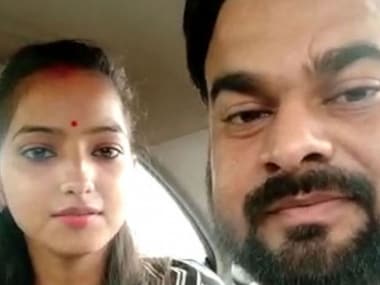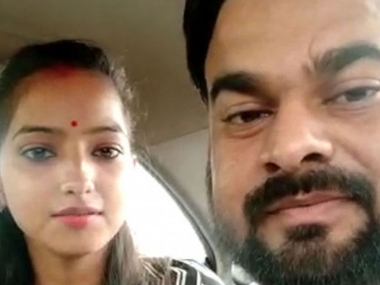It is possible to discern in the two videos of Sakshi Mishra the multiple methods through which the young are challenging and undermining, ever so slowly, India’s stifling caste hierarchy. Sakshi, the 23-year-old daughter of Bharatiya Janata Party (BJP) MLA in Uttar Pradesh, Rajesh Mishra alias Pappu Bhartaul, used social media as a weapon to neutralise the superior might of her father, who was allegedly opposed to her marrying Ajitesh, a Dalit. Sakshi is Brahmin. The stiff opposition of her MLA father, who Sakshi accused of sending his henchmen to track and separate the couple, confirms why BR Ambedkar considered inter-caste marriage as the principal mode of demolishing the caste system. In Annihilation of Caste, which is a veritable manifesto for establishing equality among Indians, Ambedkar noted: “I am convinced that the real remedy (for abolishing caste) is intermarriage. Fusion of blood can alone create the feeling of being kith and kin, and unless this feeling of kinship, of being kindred, becomes paramount, the separatist feeling — the feeling of being aliens — created by caste will not vanish.” [caption id=“attachment_6986381” align=“alignleft” width=“380”]  Sakshi Mishra used social media to neutralise the superior might of her father, who was allegedly opposed to her marrying Ajitesh, a Dalit. News18 Hindi[/caption] Ambedkar made this observation after summarily dismissing inter-dining as a remedy for tackling the caste system. His observation was akin to taking a swipe at Gandhi, who, quite radically for his time, promoted inter-dining for bridging the chasm between the untouchables and the upper castes – and widening the social base of the anti-colonial movement. Inter-dining has proved to be a grossly ineffective measure to tackle caste. Even today, decades after Gandhi conducted his experiments to abolish untouchability, the most favoured method of political parties wishing to muster the support of Dalits is to organise inter-dining involving them. For instance, in 2018, the BJP launched the “dinner-at-Dalit house” campaign for calming the community members whose emotions were roiled because of the Supreme Court diluting the Scheduled Castes and Scheduled Tribes (Prevention of Atrocities) Act. The campaign had BJP MLAs and ministers breaking bread with Dalits at their houses. Yet, the limitations of inter-dining came to the fore when a BJP minister, Suresh Rana, was accused of bringing food from outside and eating at a Dalit home in Aligarh. Another BJP MLA from Uttar Pradesh, Rajendra Pratap Singh, was quoted saying that Dalits feel emancipated when BJP leaders dine with them. We do not know whether Sakshi’s father, Rajesh Mishra, was among the MLAs who dined at a Dalit house. Inter-dining is rendered ineffectual because it is an occasional occurrence — partaking of meals is mostly a private affair; it is easy to suspend caste prejudices for an hour or so for the instrumental reason of bagging votes. The upper caste communities accept their leaders eating with Dalits as a compulsion of democratic politics, which has the idea of equality as its basis. Upper caste leaders must publicly endorse that idea. It was perhaps why Union minister Ram Vilas Paswan had then said, “ Pitying them (Dalits) is wrong , and thinking that eating with Dalits will eradicate untouchability is not right.” By contrast, a marriage between a Dalit and a Brahmin, as between Sakshi and Ajitesh, demands that families reject the idea of purity and pollution, superiority and inferiority in perpetuity. Marriages, unlike inter-dining, isn’t a one-off thing lasting, at best, for an hour. This makes it impossible to depict a Brahmin-Dalit marriage as instrumental to the larger Brahmin community. And because the marriage is not perceived as instrumental, it acquires the radical undertone of undermining the caste system. From this perspective, the idea of equality is not only endorsed but lived as well, every hour, daily. Sakshi and Ajitesh’s marriage rips off the mask of hypocrisy all of us wear, and demands an alignment between personal and public morality. Rajesh Mishra recently told The Indian Express, “The BJP membership drive is ongoing. We are…organising weddings of poor girls. She (Sakshi) is an adult and has the right to make her decisions.” Sakshi’s videos suggest she was apprehensive of what her father might do to her and Ajitesh. Through her defiance of her father, she has compelled him to adhere to his public avowals in the personal realm. He has had to publicly live what he espouses. Marriages in India are mostly endogamous or confined to the same social group. These are also mostly arranged. The idea of caste equality has seeped deep enough for people issuing matrimonial advertisements to declare, “caste no bar.” Often though, the consideration of caste is swept aside only when the prospective bride or bridegroom has extremely marketable attributes — for instance, either he or she has a high-paying job in the private sector or is in an elite government service. In 2013, the author of this article did a three-part series for The Hoot on the discrimination Dalit journalists face in newsrooms. An exception among them was a Bengali Namasudra, who said his only experience of caste discrimination was not in the newsroom, but when he responded to advertisements under “caste no bar” category on matrimonial websites. “When I tell them about my Namasudra background, communications cease at once,” he said. His experience shows why Ambedkar was right in identifying inter-caste marriage as the best weapon to annihilate caste. Given that marital ties in India are mostly arranged through negotiations between families, love marriage — a term used when individuals choose their own partners — becomes the only method through which it is possible to implement Ambedkar’s prescription to tackle caste. Yet the factor of propinquity (nearness in time and space), sociologists point out, leads to couples belonging to the same class and to the same category of caste falling in love and marrying. This is why the marriage between Sakshi and Ajitesh turns love into a revolt, radical act. In the absence of empirical data on inter-caste marriages involving Dalits, it isn’t advisable to construct a sociological theory. Yet, media reports highlighting the targetting of inter-caste couples — tellingly captured in the Marathi film _Sairat_ — indicate, ironically, to the growing social diversity of public places. For instance, reservation has turned education institutions relatively more socially diverse than what it was two decades ago. As the distance between castes gets bridged, the idea of equality and that of love recognising neither caste or religious boundaries, promoted through films, TV, social media and print, tend to normalise inter-caste marriage for the young. The Sakshi-Ajitesh love saga could not have been possible without social media. Her videos, which went viral, have ensured security to the couple. Social media in their story has become a weapon for battling patriarchy and political might, for countering the hegemonic ideas pertaining to caste, religion, love and marriage, for creating a community of like-minded people wishing to uphold normative values. Sakshi’s dare also mounts a challenge to all those who were critical of the film _Article 15_ , which depicts a Brahmin hero combating caste in Uttar Pradesh. The film has been faulted for showing the principal beneficiary of the caste system risking his life and office in an individual effort to flatten the caste hierarchy. This critique presumes that beneficiaries will not dismantle the system from which they gain. Sakshi Mishra has proved captious critics of Article 15 wrong. Sakshi is the real-life equivalent of the Brahmin protagonist of Article 15, not least because she refused to be reduced to her “immediate identity and nearest possibility,” the phrase Rohith Vemula, the Hyderabad Central University student, used in the note he wrote before committing suicide in January 2016.
Sakshi, the 23-year-old daughter of BJP MLA Rajesh Mishra, used social media as a weapon to neutralise the superior might of her father, who was allegedly opposed to her marrying Ajitesh, a Dalit.
Advertisement
End of Article


)

)
)
)
)
)
)
)
)



